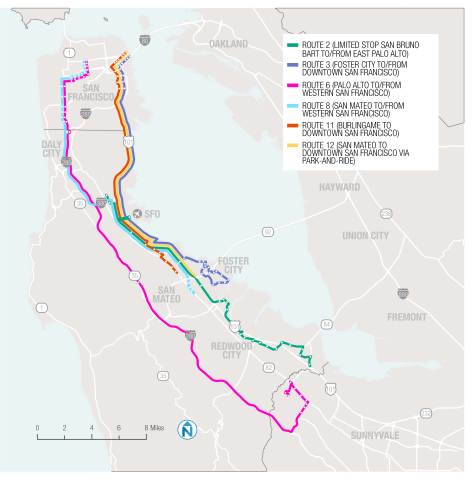SamTrans US-101 Express Bus Feasibility Study
US-101 through San Mateo County is one of the most congested freeways in the Bay Area. The SamTrans US-101 Express Bus Feasibility Study is exploring the role express buses can play in providing mobility options on US-101 and adjacent roadways like I-280 that strengthen connectivity to jobs and housing hubs throughout the region. Together with other improvements and transportation demand management initiatives, the implementation of viable, time-competitive public transit options on US-101 has the potential to help meet the region’s future transportation demands. This project has been made possible by a grant from the California Department of Transportation (Caltrans) and a grant from the Regional Planning grantmaking strategy of Silicon Valley Community Foundation.
What are the Express Buses?
Express bus service can provide faster transit service to key commuter destinations than traditional local bus services. In general, express bus routes make few intermediate stops, reducing travel time compared to local bus routes. Riders benefit from the reliable travel times offered when buses travel in high occupancy vehicle (HOV) lanes.
About the Study
The Study examined the financial and operational feasibility of a network of long-distance express buses operating on US-101 through San Mateo County, potentially integrated with managed lanes that provide access to high-occupancy vehicles. The results of the Study will help SamTrans determine if there is a viable market for long-haul express bus services through San Mateo County serving adjacent cities.
The Study team conducted the following tasks:
- Assess the financial and operational feasibility of a network of long-distance express bus service along the US-101 freeway corridor.
- Identify key regional travel markets located in or traveling through US-101 in San Mateo County.
- Define transit performance objectives within the corridor
- Engage community members and stakeholders in developing potential express bus routes that expand their mobility options for long-haul trips.
- Develop transit ridership forecasts and conceptual operating plans for potential express bus routes.
- Engage community members and stakeholders in developing potential express bus routes that expand their mobility options for long-haul trips.
- Develop transit ridership forecasts and conceptual operating plans for potential express bus routes.
- Identify potential transit-supportive facilities, including park & ride lots (PNR) and multimodal access facilities or hubs, to help close first-mile/ last-mile gaps.
- Explore alternative funding and/or financing opportunities.
- Evaluate alternatives and select a preferred alternative to move forward for further study.
- Share findings and lessons learned in a Final Report.
Goal 1: Provide Mobility Options for Regional Trips
Goal 2: Increase Transit Market Share in Corridor
Goal 3: Develop a Cost-Effective Service
Goal 4: Improve Transportation Equity
Goal 5: Enhance Access to Jobs and Population Centers
Goal 6: Support Sustainable Land Use and Transportation Policies
What did the Study find and what happens next?
SamTrans launched this study in April 2017 and completed a final report in November 2018. Over the course of the study, the team completed a detailed market analysis and identified an initial set of 15 potential express bus routes throughout the three-county study area. Over two rounds of evaluation, the initial routes were screened against a set of goals and performance metrics such as anticipated ridership, ability to serve new transit markets, and cost per passenger.
Of the 15 initial route concepts, the study is recommending a phased implementation of six new express routes. A map of the proposed route network is shown below. SamTrans staff will soon begin preparing for the launch of a pilot re-introduction of express routes in Phase 1 which would include Route Concepts 3 and 6. Staff will be identifying funding needed for this phase and future phases and conducting more outreach and marketing to communities near the proposed routes. The new express service will be funded in part through SB1 funds.
Opportunities to Participate
The project team welcomed stakeholder input throughout the project. The study team held two community meetings and tabled at six community events throughout the Study area in July/August 2017 and June 2018.
Project Materials
Please see the fact sheet for more information about the project.
